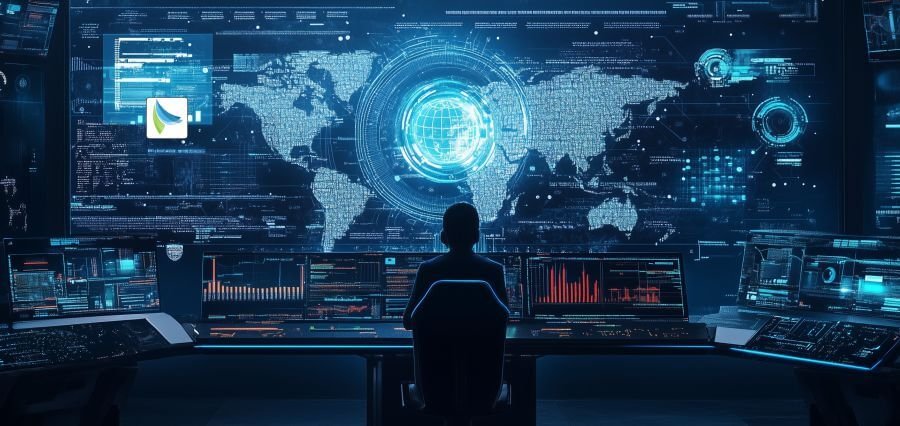AI-Powered Cybersecurity
With the cyberattacks becoming increasingly clever, the traditional security cannot cope with the assertiveness and brilliance of the cyberattacks. Corporations are also moving towards adopting artificial intelligence (AI) and machine learning in order to heighten their cybersecurity even more. With intelligent technology, there is prompt threat discovery, real-time response, and proactive analytics that prevent cyberattacks from happening in the first place. AI-powered cybersecurity is transforming businesses, governments, and individuals how they protect information from sophisticated cyber attackers.
The Dynamic Cyber Threat Environment
The age of the internet has ushered in an era of unprecedented ease, but one that has also brought a new age of cyber attacks. Cyber attackers employ all available methods of attack, ranging from ransomware and phishing to denial-of-service (DoS) attacks and infection with malware. With nearly every company doing business nearly entirely online, threats of cybercrime have never been higher.
Legacy security practices rely on programmed rules and human decision-making, difficult to keep up with changing threats. AI and machine learning address this problem using big data analysis, identification of anomalous patterns, and enforced security practices. AI and machine learning enhance security practices, allowing organizations to amplify threat detection and response.
How Machine Learning is Revolutionizing Cybersecurity
Machine learning (ML), an AI subset, enables computers to get smarter over time without explicit programming. Machine learning algorithms comb enormous amounts of data to find patterns in cyber malice. With continuous learning of new threats, machine learning enables organizations to be one step ahead of cyber criminals.
One of the benefits of ML in cyber security is that it can identify anomalies. Security software has historically relied on pre-programmed rules to block known attacks, but ML can identify abnormal behavior even if it is an unknown or unseen attack. This pre-emptive feature eliminates the possibility of stealthy cyber attacks.
Besides that, ML-powered systems are also able to scan vast volumes of security logs, emails, and network traffic in real-time. Automation releases the workload of cybersecurity teams to focus on strategic decision-making instead of manually examining every possible threat.
AI in Endpoint Security and Malware Detection
These are computers, mobile phones, and IoT devices, which are all the preferred targets for cyber attacks. Conventional anti-malware technologies employ signature-based detection, which can only identify known types of malware attacks. AI enhances endpoint security by detecting new and novel malware samples.
Machine learning technology monitors file habits, run history, and system routines to look for bad habits. Even never-before-seen malware are also identified by AI technologies and cross comparison with past attacks by the pattern of similarity. The sophisticated counter measures work pro-actively protecting organizations by stopping malware attacks even before they can cause any damages.
Cybercriminals would most probably target e-commerce websites, banks, and online services with fraud too. Fraud detection software utilizes AI to scrutinize user behavior and transaction records in an effort to identify probable fraudulent transactions. When a bank client makes strange huge transactions from various locations in a short space of time, AI can identify the transaction as suspect and trigger more verification processes.
Similarly, AI enables identity protection through notifications on unauthorized account access attempts. Biometric security features and multi-factor authentication use AI in authenticating users through face, fingerprint, or voice. These features are more challenging for criminals to achieve unauthorized access to secured accounts and, therefore, improve security.
Challenges and Ethical Issues in AI-Driven Cybersecurity
Though helpful, AI-based cybersecurity has its disadvantages as well. Cyber attackers are also exploiting AI to develop more advanced attacks, and hackers and defenders are now engaged in a never-ending battle. AI-based phishing attacks, deepfakes scams, and botnet hacking tools are some of the developing threats that call for round-the-clock innovation in defensive technologies in cybersecurity.
Secondly, there must be high-quality and diverse datasets to train AI models so that they are not disadvantaged by biases and false positives. It can cause harm to business operations if an AI-based cybersecurity solution labels legitimate user activities as a possible threat. AI solutions need to be practical, and finding the proper balance of usability and security is important in that regard.
There are ethics problems when AI is used for surveillance and monitoring as well. Businesses must be certain that AI-based cybersecurity controls are in accordance with data protection legislation, such as the General Data Protection Regulation (GDPR) and the California Consumer Privacy Act (CCPA). AI decision-making transparency and good data handling practices are necessary to enable the sustenance of public trust.
Conclusion
AI-driven cybersecurity is revolutionizing the security landscape of how companies are shielded from cybercrime. Using real-time threat identification through machine learning, predictive analytics, and response automation, AI equips security solutions for industries. Ranging from fraud defense to malware identification, AI-driven solutions deliver an active defense to digital assets security.
But since cybercriminals are employing AI to make their attacks dynamically adaptable, organizations will need to stay one step ahead of the game with ongoing advancements in AI-driven cybersecurity. Ethical concerns, data protection, and the use of AI correctly will be the cornerstones of what will determine the future of cybersecurity. AI-driven cybersecurity is no longer an extravagance but a sheer necessity to safeguard sensitive data confidentially and earn the trust of cyberspace.
Credit: insightssuccess.com











